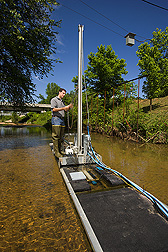This page has been archived and is being provided for reference purposes only. The page is no longer being updated, and therefore, links on the page may be invalid.
Read the magazine story to find out more. |
|
"Sound" Technology Used in Sediment Research
By Luis PonsAugust 22, 2006
You've heard the expression "putting your ear to the ground." But, putting your ear to the water? That's what technology is helping Agricultural Research Service (ARS) scientists in Oxford, Miss., do.
Hydraulic engineers Roger Kuhnle and Daniel Wren of the ARS National Sedimentation Laboratory (NSL) and collaborators are using acoustics and automated sampling to assess how sediment impacts waterways and dams.
They're applying acoustic science to measuring the rate at which sand and gravel are transported in streams. The resulting data can give insight about upstream erosion and—with help from computer modeling—fortify predictions about sediment's impacts on water bodies and related structures.
This research is part of work by scientists in Oxford and at other ARS locations that's aimed at helping agriculture and waterways coexist in a cost-effective, environmentally friendly fashion. At NSL, one research area focuses on how erosion, soil runoff, and urban and industrial activities affect water quality.
As part of this work, Wren and other collaborators are improving use of a core-drilling technique, called "vibracoring," for gauging sediment's impact on aging reservoirs. They're particularly interested in how vibracoring helps detect rates and patterns of sediment collection that affect reservoirs' holding capacities.
Meanwhile, data collected from the Mississippi Delta region's waterways is helping NSL scientists improve computer programs and models used to evaluate how different management practices can affect entire watersheds.
Agricultural engineer Ron Bingner is working with water-quality-prediction technology known as AnnAGNPS (for Annualized Agricultural Nonpoint Source) to simulate environmental processes and evaluate their impact on downstream and adjacent watershed elements. And hydraulic engineer Eddy Langendoen is using field studies and a computer modeling technique he created called "CONCEPTS" (for Conservational Channel Evolution and Pollutant Transport System) to assess the stability of specific channel reaches.
Read more about this research and other ARS projects related to a healthy environment in the August 2006 issue of Agricultural Research magazine.
ARS is the U.S. Department of Agriculture's chief scientific research agency.

